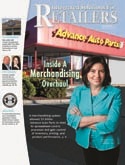Inside A Merchandising Overhaul
By Erin Harris, associate editor
 A new merchandising system allowed $5 billion Advance Auto Parts (AAP) to shed its spreadsheetcentric processes and gain control of inventory, pricing, and product performance.
A new merchandising system allowed $5 billion Advance Auto Parts (AAP) to shed its spreadsheetcentric processes and gain control of inventory, pricing, and product performance.
You won’t hear any horror stories from Advance Auto Parts about the recession. As motorists tough out a weak economy by choosing to repair their jalopies instead of buying new cars, they turn to companies like AAP, a tier-one automotive aftermarket retailer that boasts 3,500 stores in 39 states, 51,000 employees, and caters to DIY (do-ityourself) and DIFM (do-it-for-me)/commercial customers. Commercial customers account for about 34% of AAP’s revenue while do-it-yourselfers generate the balance. Indeed, the numbers speak for themselves; AAP’s revenue is $5 billion. Impressive figures such as these lead you to believe that AAP has run a smooth retail operation from day one — complete with visibility into product performance and cost and automated applications to sufficiently predict future growth. But, in fact, the opposite was true. AAP relied on spreadsheets and ad hoc tools for merchandising and pricing for the entire chain. To grow revenue, remain competitive, and overcome the painful hurdles associated with a lack of systematic tools, the company needed to implement an automated merchandising system.
Get unlimited access to:
Enter your credentials below to log in. Not yet a member of Retail IT Insights? Subscribe today.
